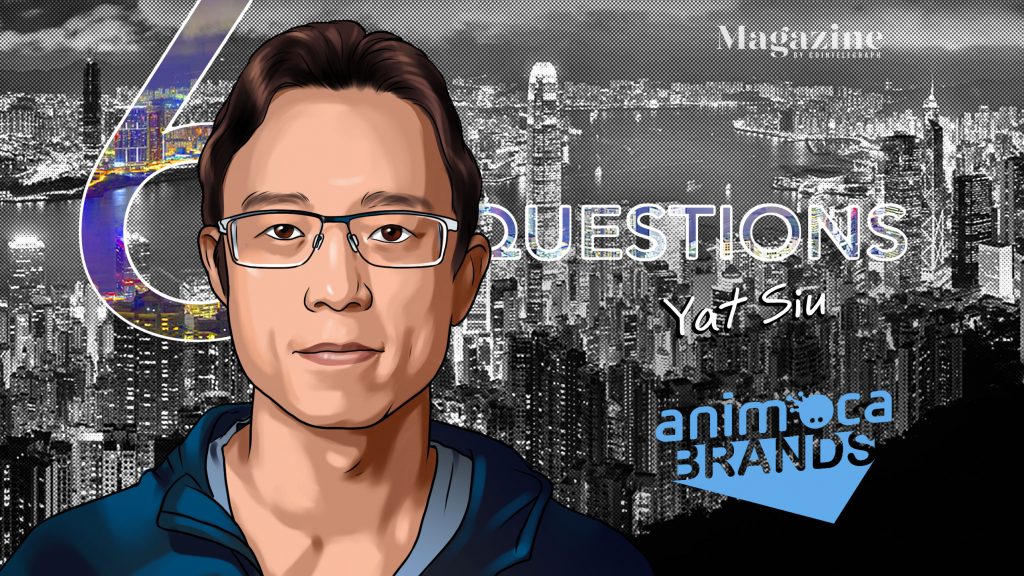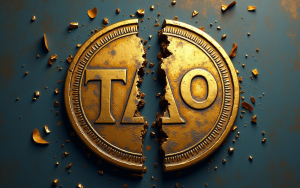6 Questions for Yat Siu of Animoca Brands – Cointelegraph Magazine

We ask the buidlers in the blockchain and cryptocurrency sector for their thoughts on the industry… and we throw in a few random zingers to keep them on their toes!
This week, our 6 Questions go to Yat Siu, the co-founder, group executive chairman and managing director of Animoca Brands, who leads various NFT projects.
A veteran technology entrepreneur and investor, Yat is the co-founder, group executive chairman and managing director of Animoca Brands — a global leader in blockchain and gaming with the mission to deliver digital property rights to the world’s gamers and internet users. Animoca seeks to create a new asset class, play-to-earn economies and a more equitable digital framework contributing to the building of the open Metaverse.
Yat began his career at Atari Germany in 1990. In 1995, he moved to Hong Kong to establish Hong Kong Cybercity/Freenation, the first free webpage and email provider in Asia. In 1998, he set up Outblaze, an award-winning pioneer of multilingual white label web services. In 2009, he sold Outblaze’s messaging unit to IBM and pivoted Outblaze to become an incubator of projects and companies to develop digital entertainment services and products. One of those incubator projects is Animoca Brands.
1 — From smart contracts to DApps, NFTs and DeFi, we have seen so many of crypto’s next “killer apps,” but none have really taken off yet. What will stick?
The killer apps for crypto are already here, they’re just in need of further growth and penetration. Gaming is the killer app — more specifically, GameFi. Games like Axie Infinity and The Sandbox have captured the imagination of thousands and have grown accordingly by enabling their users to own their own game content and benefit materially from that content. The top DApps tend to be games (DappRadar currently lists six games in the top 10 DApps), and I do not expect that to change.
2 — If you were investing in startup companies right now, what kind of blockchain-based business opportunities would catch your eye?
As it happens, we are, in fact, actively investing in blockchain companies (startups and non-startups) all over the world. We are particularly interested in projects that can drive mass adoption, and in this we consider Metaverse-related companies to be critical to future growth. By that, I don’t just mean Metaverse world builders but also the companies that provide open assets that will be used in the Metaverse — for example, virtual car builders as opposed to an entire racing game.
Another important quality that we look for is openness. We invest in projects that grow the open Metaverse and facilitate the delivery of true digital property rights based on assets that derive their utility from being open, interoperable and composable. This includes platforms and protocols (Flow, Polygon, etc.) and marketplaces (OpenSea, Bitski, BNV, etc.), as well as consumer products like games and worlds. In essence, the companies that we invest in must be open to openness.
My concern is that the large Web 1.0 and 2.0 companies, which already enjoy a massive user advantage, will try to shape the Metaverse into a series of closed systems operated on their terms and under their total control. These proprietary metaverses are not likely to be very democratic and will lack the openness and digital property rights that should rightfully characterize the next iteration of our online experience.
I think that tech giants like Facebook are unlikely to offer their metaverse users any meaningful degree of ownership — or they might do so at face value, but then implement strict content and usage licenses as we see in social media services today. Without digital property rights, it will not be possible to create a democratic, responsible, equitable Metaverse.
3 — Which countries are doing the most to support blockchain — and which ones will be left behind?
The winners in this arena will be countries with a history of serving alternative and/or fast-growing financial products and that are highly supportive of blockchain — such as Liechtenstein, Singapore and Switzerland. Other winners will include highly developed economies that have contributed to and promoted the blockchain industry — Germany, for example, where spezialfonds allow pension funds and insurers to hold up to 20% of investments as cryptocurrencies, and where the stock exchange (Deutsche Boerse) and a major bank (Commerzbank) have already invested to support the trading of NFTs.
Countries that experiment and invest in the blockchain space will attract growth and the best and brightest talent, and those that don’t will miss out not only on the benefits of the technology but also on the talent. One example of this is how Australian crypto companies are moving to places like Singapore and drastically lowering Australia’s competitive capacity in this important, growing segment of technology and finance.
This alert about Australia’s missed opportunity is being sounded not only by crypto pundits and similarly interested parties but also by respected industry sources such as the CEO of National Australia Bank, one of the major financial institutions in the country.
Countries with a well-established culture of disruptive innovation, such as the United States, continue to forge ahead in blockchain despite the risks involved and the lack of clarity from regulators. I think that the U.S., despite having more regulation, will remain a key environment for blockchain-related companies and associated venture capital (global crypto growth is fuelled in significant part by U.S. venture and other capital). Regulation is important, and I hope it can be achieved without stifling growth and innovation.
The biggest losers will be countries that reject applications of blockchain (including crypto) and, particularly, countries that reject the entire digital asset space. The use of fungible and nonfungible tokens provides an open, transparent value system where growth is being driven by the network effect. The more people join this new open system, the stronger it becomes, while the old closed networks become more isolated and less attractive.
For a nation, rejecting blockchain and crypto is like refusing to join the World Trade Organization and saying no to global free trade.
4 — What talent do you lack and wish you had? How would you use it if you had it?
I’m a terrible singer, which is ironic because my mother is a former opera singer and director and I actually studied music. I had to sing as part of my entrance exam to the music conservatory, and it was tough. If I could sing well, I would probably be more active musically, as singing is such an easily accessible expression of culture (it can be done anywhere, anytime, with no equipment, alone or in company).
I would definitely appreciate being able to perform as a singer instead of just being a listener, especially because so much of my work entails the translation and delivery of culture of various forms. However, a lack of talent for singing means that I leave this activity to the rest of my family, especially my mother.
5 — If you didn’t need sleep, what would you do with the extra time?
Right now, I would probably use most of the extra time to work more — there are so many important things to do, and I really enjoy my work! But if I really didn’t need to sleep, I would attempt to distribute the extra time equally to more work, more family and more personal time. Family time does sometimes involve me buying NFTs and playing games with my kids (my oldest son is an active blockchain gamer and NFT collector), so some of the family time might also count as work time, which works for me!
6 — What was the most embarrassing moment of your life?
I love to hike. Several years ago, I went hiking with a friend on Lantau Island in Hong Kong. We ended up struggling through a densely vegetated headland where it was uncomfortably hot and humid. We were scratched by sharp branches, assaulted by swarms of insects and gagging on air that smelled foul — one of those situations when hiking is just not fun. A stone’s throw away, through the shrubs and the haze, we glimpsed the sea. We agreed that it would be much nicer to walk along the water while enjoying the fresh sea breeze, so we headed that way.
We exited the tangled vegetation and came to the top of what I must now admit was a sheer cliff. Below the cliff, a strip of rocks met the sea. My friend pointed out that there was no way for us to get down the cliff, but at that point, all I wanted to do was leave the insect-infested shrubs behind us, and the only other way was down the cliff.
It was a brutally hot day, and I may have had a touch of heatstroke. I’ll let Ibrahim El-Mouelhy, my hiking companion on that day and our chief communications officer today, describe the event:
“Yat has always been a risk-taker and an optimist, and this was particularly evident on that day. He strode purposefully to the cliff’s edge and asserted, with great confidence, that we would be able to climb down to the beach. To me, the cliff looked dangerously high and steep, and the ‘beach’ resembled a jumble of jagged rocks. Yat took off his backpack and hurled it over the cliff. Then he casually turned around and hopped backward over the edge.
“I stood paralyzed in shock and horror, convinced that this was the end of Yat Siu, future captain of industry but now a tragic victim of sunstroke. Almost immediately, however, I heard his loud calls for help. I rushed to the edge of the precipice and looked down, where I saw Yat struggling to hang on to spiky grasses and fraying earth at an unquestionably vertical incline. He had evidently had a change of mind regarding the negotiability of his route and was now simply endeavoring to avoid plummeting to his likely demise. Far below him, the rocks looked particularly jagged and sharp.
“Bracing myself, I reached down and grabbed Yat’s hand. I’m a big guy and used to lifting weights, so I thought pulling him up would be easy. Wrong. When I tried to hoist him, our combined mass caused my foot to break right through the cliff edge, which turned out to consist of matted vegetation and dirt instead of the bedrock that would have been so much more appropriate for these Hollywood-style antics.
“I very nearly went over the cliff myself as its edge disintegrated beneath our weight. The situation had quickly deteriorated from an ordinary one-armed pull into a harrowing attempt to defy death. Every time that I took a step back from the cliff’s edge, the ground would collapse under me and I’d have to throw myself backward while still hauling on Yat’s arm. In this manner, we scrambled back to safety. It probably only took a few moments to pull Yat off that cliff, but they were some extremely tense moments. Fortunately, we made it out alive and in one piece.
“After all that, we had to go back into the hellish shrubs and hike for over an hour to find a (conventional) way down to retrieve Yat’s backpack.”
A wish to the blockchain community:
The blockchain community has, in aggregate, the incredibly important task of building the open Metaverse, where users will be able to own their assets and data. To own your data is to own your future and to be free. This future requires our young people to build (and build in) the open Metaverse and create sufficient mass and relevance so that even closed systems will need to embrace openness — very much how open source changed closed source (the world would be very different today without the open-source movement of the past decades.)
I wish for all young, ambitious entrepreneurs to prioritize openness, fairness, collaboration and interoperability in their work, and to strive to provide the best possible products not only for crypto enthusiasts but also (and especially) for the billions of users who have yet to enter the world of crypto.















